
The Best Low-Code Platform: Explore the Top 11
Do you want to find out which are considered top enterprise low-code platforms? This article explores the best ones on the market that will help you scale your projects and business practices.
Low-code development platforms aren’t going away. On the contrary, they are evolving to keep up with modern-day technological movements spanning the evolution of AI, Generative AI (GenAI), and deep learning through hyperautomation and edge computing to co-creation and fusion teams, and more.
These automation tools have already become inevitable in modern app development. Why? Faster time to market is now a significant business advantage and having the best low-code platform to innovate quickly and efficiently is essential.
| Platform | Key Features | Best For | Unique Strengths | Licensing Model |
|---|---|---|---|---|
| App Builder | Code gen for Angular, React, Web Components, Blazor, Figma-to-code, App Builder AI, GitHub integration, 65+ UI components, DesignOps & DevOps, No vendor lock-in | Enterprise apps, digital transformation, composable strategies, prototyping, usability testing | Full design-to-code cycle with real-time preview, extensive design system (Indigo.Design), ideal for experienced developers, citizen developers, C-level executives | Subscription-based, with free trial |
| OutSystems | Full-stack development, Auto-scaling, drag-and-drop builder, DevOps automation, Real-time monitoring, performance dashboards, seamless integration, codebase generation | Mobile app development, designing complex UIs | Accessibility compliance (WCAG 2.1 AA, Section 508), enterprise-grade deployments, pre-built AI components | Tiered pricing |
| Mendix | Multi-channel apps, Integrated collaboration tools, Proactive and context-aware app management, Development and operations (DevOps), Multi-cloud deployment, Open and extensible integrations with APIs, AI-assisted development | Business agility, enterprise automation, co-creation | Strong for enterprise workflows, collaborative teams, and component-based architecture | Free tier for small apps, subscription for enterprise tiers |
| Builder.io | AI-powered front-end development, Drag-and-drop- Figma-to-code, Headless CMS integration | Visual front-end, design-to-code, quick iterations | Visual content creation and rapid experimentation | Usage-based and team-based pricing; free tier available |
| QuickBase | Spreadsheet replacement, Pre-built components, Data handling, AI capabilities | Ops and project teams, automating workflows, quick app rollout | Non-technical teams, spreadsheet-heavy workflows, fast digitization | Subscription-based, with free trial |
| Pega | Robotic Process Automation, Case management & business management, AI workforce insights | Enterprise automation, digital transformation, CRM | Email bot, X-ray vision to reduce upfront effort, robotic workforce | Case-base pricing |
| WaveMaker | Full-stack dev, VCS control, API mocks, 1-click preview, Debugging tools, Mobile testing | IT teams, scalable enterprise apps | Built for professional developers with enterprise governance and extensibility | Subscription-based and self-hosted options |
| Appian | Business Process Management, One-click deployment, Social collaboration, IoT integration, IE11 support | BPM apps, reports, analytics, case management | Robotic Process Automation and strong mobile/offline support | Subscription-based, priced per user, month, app |
| Betty Blocks | Drag-and-drop blocks, Visual modeling, Web service integration, Templates, Variables, | Citizen developers, legal, finance, construction | Highly accessible for non-developers, reusable blocks, | Subscription-based |
| Zoho | Prebuilt integrations, Role-based access, Real-time analytics, Deluge scripting, Workflow automation | SMBs, startups, internal tools, workflow automation | Built-in camera, barcode, and maps functionality in the BPM tool | Subscription-based |
| Anima | Code generation (React, Vue, HTML), Smart layout/layers, Animations, Previews in the browser | High-fidelity prototypes, bridging design-dev gap | Strong Figma/Sketch/XD plugin support, seamless prototype-to-code for design teams | Pricing is based on seats, code exports, and hosted projects/screens |
What Is the Best Low-Code Platform? Here Are the Top 11.
App Builder
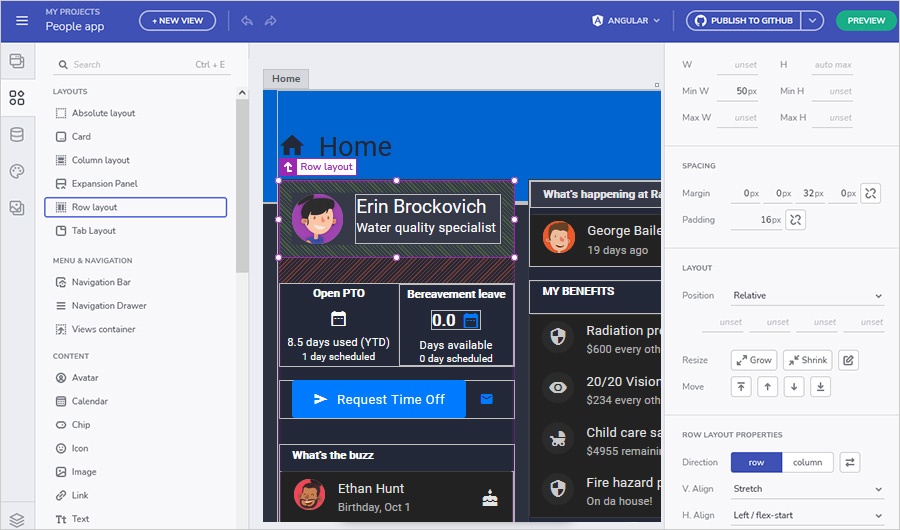
App Builder is a low-code, WYSIWYG app development tool that streamlines everything from design to code. It is crafted for businesses and teams of all sizes, enabling them to build modern software solutions faster, create a single source of truth for everyone, streamline collaboration, make data-driven decisions, and undergo digital transformation smoothly by automating key processes using DesignOps and DevOps. Most of its components arrive with built-in presets to support common usage scenarios. There are also pre-built sample applications and layout templates, allowing developers to get started with a functional app shell.
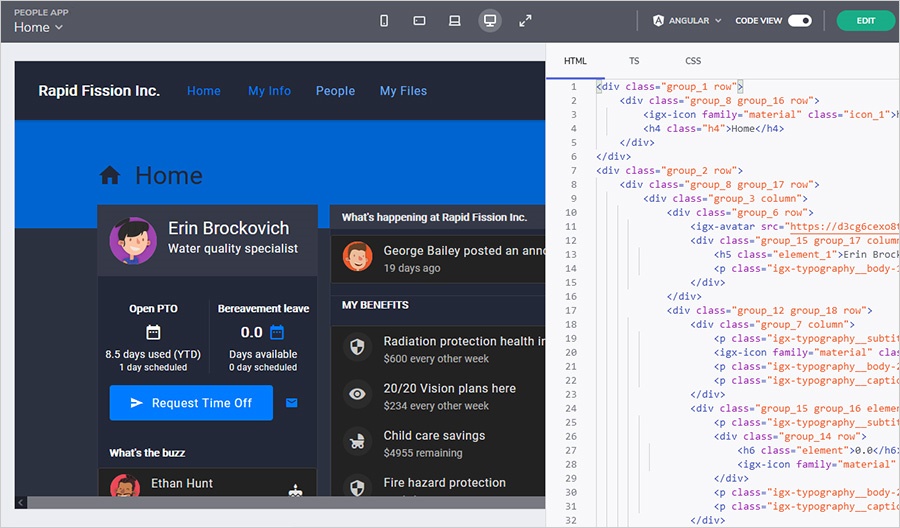
Key features:
- Code generation for Angular, React, Web Components, and Blazor
- Instant code preview that lets you interact with the design to check how the running app will look, feel, and work
- GenAI capabilities for views, images, and data source generation with App Builder AI
- Ability to create apps from existing designs, Sample apps, Default layouts, or from scratch
- Ability to convert Figma design files to code
- Intuitive interface
- Flex layouts
- 65+ reusable UI controls and options to modify the position of the nested UI elements
- Interactions that can be set up between components and views, or just between components
- Data binding
- User and usability testing
- A complete Design System – Indigo.Design
- Pre-built themes (Material, Bootstrap & Fluent), configurable panels, styles, typography, and more
- Single-page/master-detail apps creation and rich navigation with routing
- GitHub integration of the generated code output
- No vendor lock-in
- Rapid app development
- On-premises
Best for: building enterprise-grade apps, e-commerce apps, fintech, travel applications, and team collaboration; prototyping, user and usability testing; composable business strategies, digital transformation, legacy optimization, automating workflows, and accelerating development times. It is ideal for experienced programmers, citizen developers, designers, and stakeholders.
OutSystems
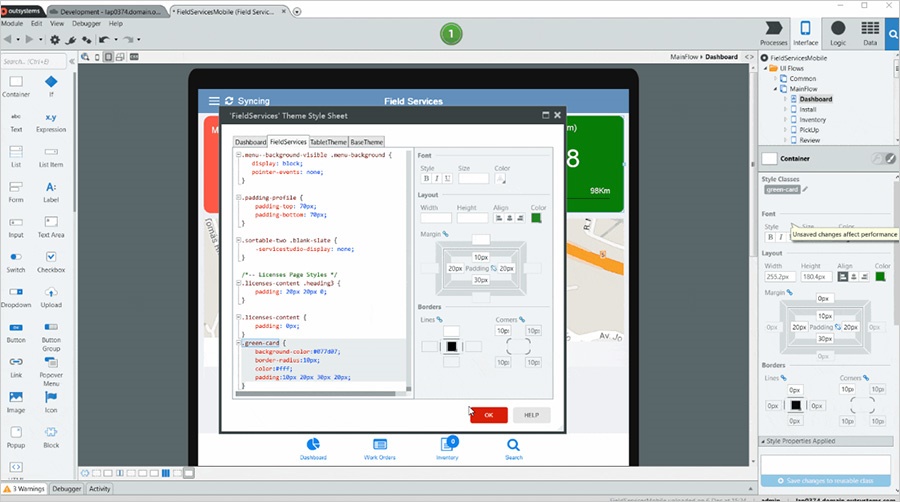
OutSystems is a full-stack AI-powered app maker that combines the ease of use of low-code functionalities and visual model-driven development capabilities. It is used for building custom UX, streamlining business processes, and improving app logic with the help of drag-and-drop elements. With an intuitive interface, excellent product performance, and a Rapid Application Development model.
Key features:
- Load balancing and auto-scaling capabilities
- In-app feedback to improve collaboration and help solve business challenges
- Easier integration of existing systems (SaaS, infrastructure, data)
- Codebase generation
- Real-time monitoring, reporting, and performance dashboards
- Microservice architecture
- DevOps automation
- Access control and permission management.
- Drag-and-drop builder
- Fully secured functionality
- Integrated debugging engine
- Multilingual support
- Full support for Batch Processes & Scheduling
- Workflow builder
- Pre-built AI components
Best for: mobile app development, creating accessible applications that comply with WCAG 2.1 AA and Section 508, designing complex UIs, and deploying reactive web apps for great experiences on mobile apps and wearables through AR/VR.
Compare App Builder vs OutSystems in this blog post.
Mendix
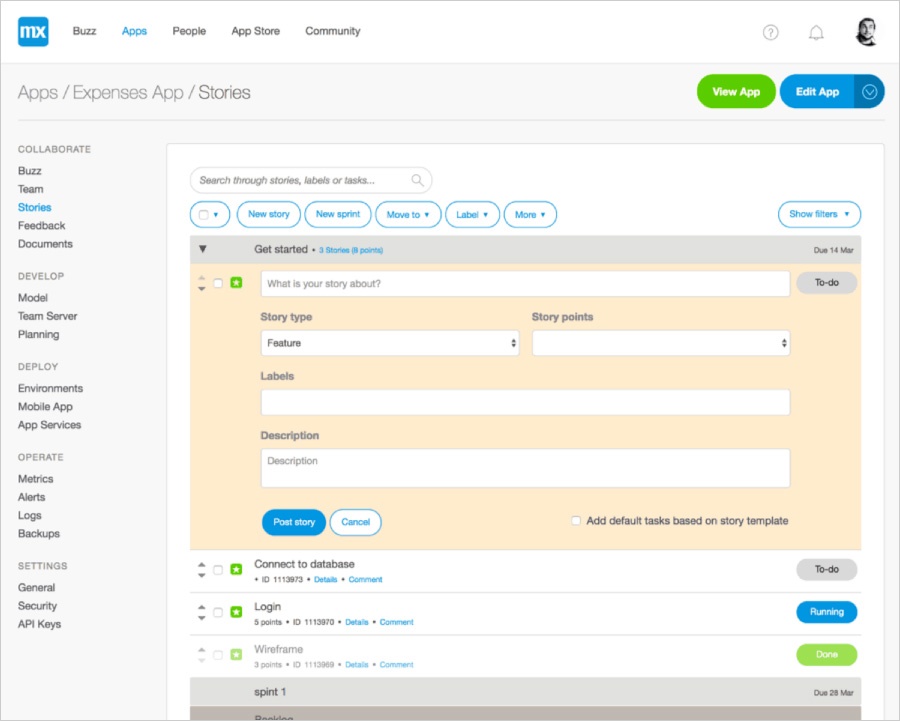
As a low-code enterprise application platform, Mendix is used for bootstrapping applications from scratch providing a data-driven architecture with plenty of integration capabilities and agile development to eliminate complexity during the software development life cycle. One of the key advantages of this low-code platform is that it enables multiple apps to be integrated into a component-based platform through microflows, empowering co-creation.
Key features:
- Multi-channel apps
- Integrated collaboration tools
- Proactive and context-aware app management
- Development and operations (DevOps)
- Multi-cloud deployment
- Open and extensible integrations with APIs
- AI-assisted development
Best for: bootstrapping ideas, improving business process agility and enterprise process automation, accelerating app development
Compare App Builder vs Mendix in this blog post.
Builder.io
It is an AI-powered visual development platform that enables teams to quickly generate, iterate, and optimize web and mobile experiences. Builder.io works by connecting to your existing site or application, enabling you to create, manage, and publish content across various platforms.
Key features:
- Rapid app development
- AI functionality
- Integration with third-party app
- Converting Figma designs to code
- Drag-and-drop components
- Code generation (limited)
Best for: visual front-end development for websites and web apps, converting designs to code, and integrating with headless or modern front-end frameworks.
Compare App Builder vs Builder.io in this blog post.
QuickBase
QuickBase is a low-code platform designed to help businesses build custom apps that streamline workflows, automate processes, and enhance operational efficiency without requiring extensive IT resources. It’s especially favored by operations, project management, and business teams looking to digitize manual processes fast.
Key features:
- Rapid app development
- Pre-built components
- AI functionality and scalability
- Handling data
Best for: operations and project teams that need to build custom apps quickly without coding, automate workflows, and replace spreadsheets or legacy tools.
Compare App Builder vs QuickBase in this blog post.
Pega
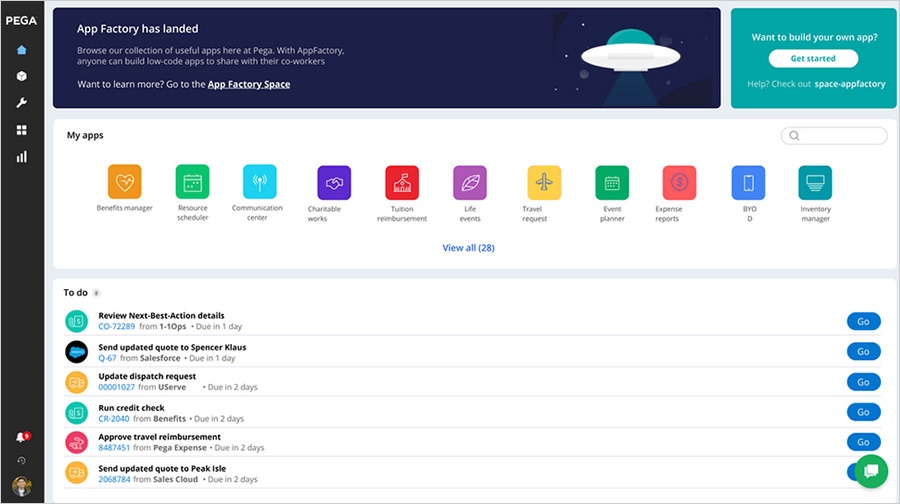
Pega is part of the unified, enterprise-level customer relationship management (CRM) platform, Pega CRM, which delivers digital process automation through its patented attended automation and personal bots. Pega is primarily used for robotic process automation (RPA), which automates repetitive tasks and integrates legacy systems for case management, as well as for low-code UI development.
Key features:
- Attended and unattended robotic process automation
- Case management and business process management
- Auto-balancing robot resources
- Email bot
- X-ray vision to reduce upfront effort
- Workforce intelligence using AI
Best for: digitalization and automation of business processes, collaboration, and better-synced work across departments while building enterprise apps, UI creation
Compare App Builder vs Pega in this blog post.
WaveMaker
This is among the best low-code development platforms purposely built for enterprise engineering. WaveMaker emphasizes extensibility, full-stack development, and enterprise-grade deployment, making it an ideal choice for IT-heavy environments.
Key features:
- Ingrained VCS control, branch support for hotfixes, and a built-in collaborative environment
- With a code-behind approach
- Out-of-the-box components
- Intellisense editor
- API mocks
- 1-click preview,
- Automated mobile testing
- Inspection framework and debugging
- Styles, fonts, and colors to create brand-specific themes
Best for: professional developers and enterprise IT teams looking to build scalable, secure, and modern web and mobile applications quickly.
Compare App Builder vs WaveMaker in this blog post.
Appian
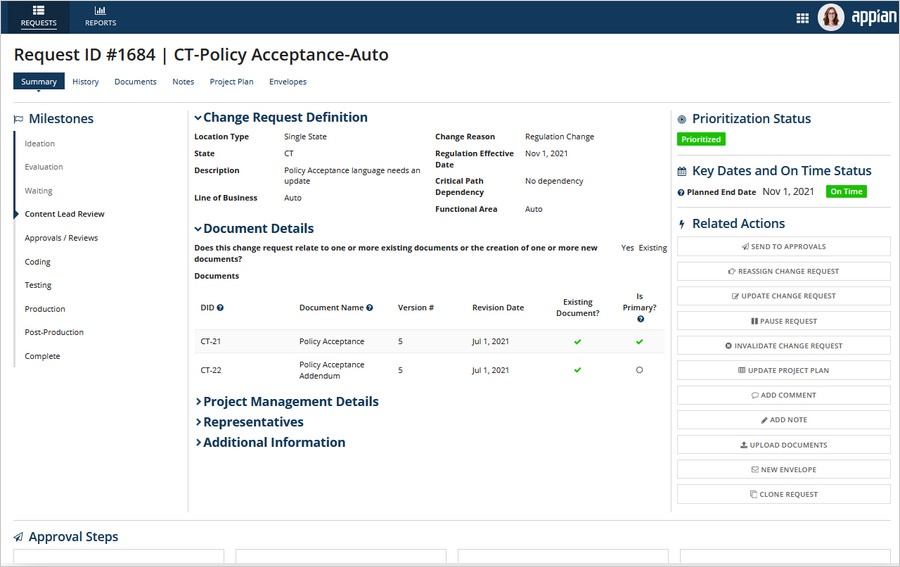
A low-code platform that has the goal of automating complex processes, unifying data, and streamlining app development by letting developers draw a workflow diagram. It allows users to create custom apps that can be easily deployed on any device. There are several deployment options, including cloud-based, on-premises, and hybrid. Appian is also used to promote better collaboration among teams.
Key features:
- Dynamic offline mobile and offline UX
- One-click deployment
- Case management
- Social collaboration feature
- Live screen sharing
- Business Process Management (BPM)
- Three-step app development
- Integrates with IoT devices
- Drag and drop actions
- IE11 support
- Robotic process automation features
- Multiuser and multi-developer features
- Seamless data integration
- Pre-built UI frameworks
- Performance monitoring and debugging capabilities
- Ability to view source objects from sites
Best for: developing business process management applications, document management, interactive reports, and data analytics
Betty Blocks
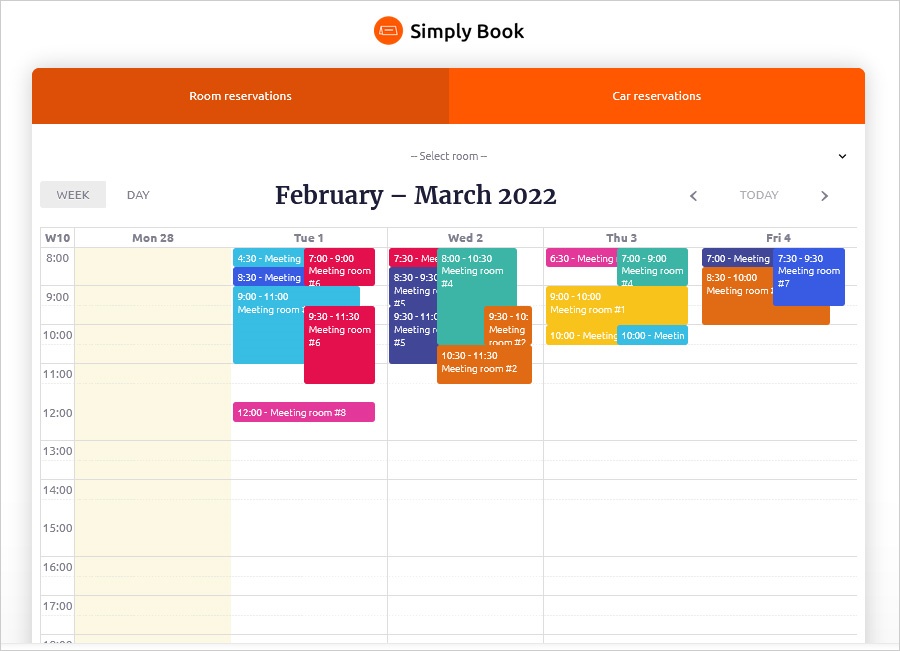
A drag-and-drop enterprise app development tool that enables users to build app workflows through a visual interface. Supporting fast development and flexibility, Betty Blocks enables parts of the application to be reused in other projects. It is entirely web-based, eliminating the need for deployment.
Key features:
- Tools and actions to define app logic
- Page builder and visual modeling
- Reusable drag-and-drop blocks
- Connects to all types of web services
- Mailboxes integration
- Fits into an existing architecture
- Data model
- Back office for administering data
- Templates
- Variables
Best for: citizen developers with no coding experience; building apps for engineering and construction, finance, insurance, and the legal sector; streamlining app creation
Zoho
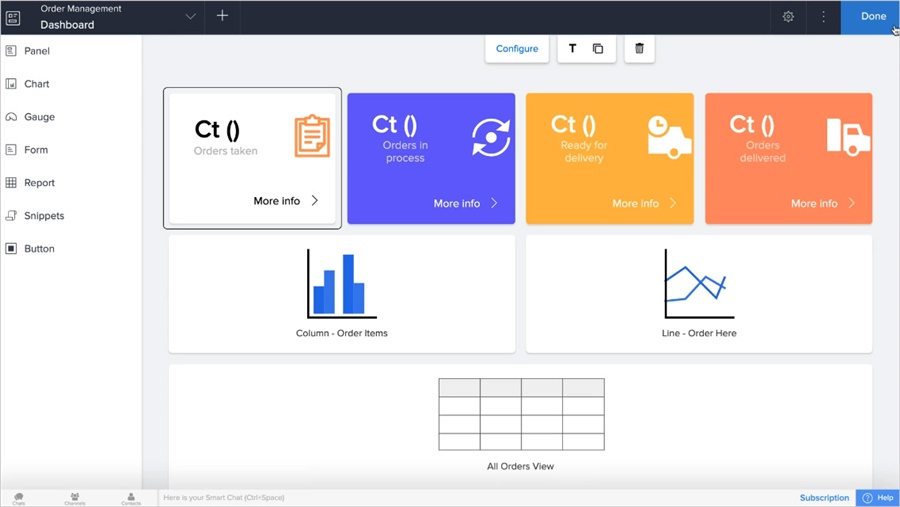
As a low-code app development platform, Zoho provides a GUI-rich development environment and relies on visual programming principles to streamline app creation. It combines drag-and-drop functionalities and requires little coding to get your project started.
Key features:
- Pre-built integrations for over 600 apps
- Ability to create custom UI components and Java libraries
- Role-based access controls for better collaboration
- Real-time reporting and cross-functional data analytics
- Powered by Zoho’s proprietary scripting language – Deluge
- Drag-and-drop interface
- Import data with AI-assisted migration tools
- Third-party apps integration
- Secure sharing, accessing, and collaboration
- REST API
- Automated workflow
- Webform
- Pre-built templates
- Built-in camera, barcode, and maps functionality in the BPM tool
Best for: AI-powered apps, mobile apps, online portals, workflow automation, enterprises, SMBs, startups
Anima
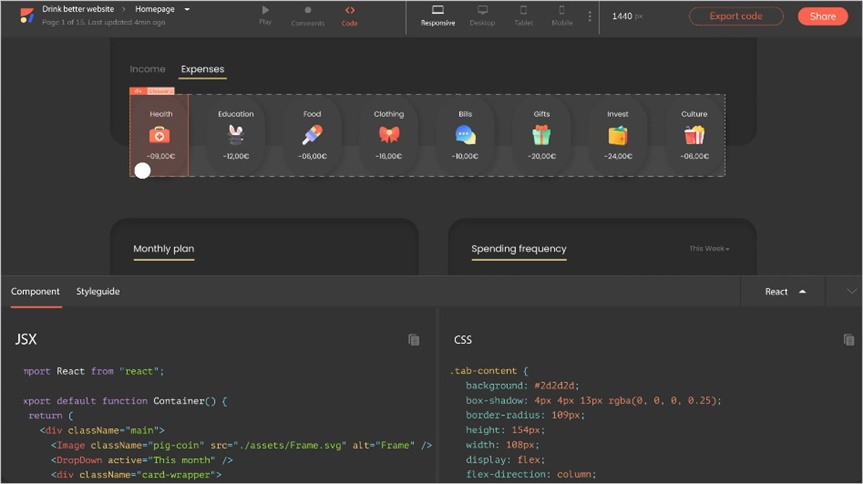
Another useful low-code tool that is used for creating high-fidelity prototypes, bringing together design and programming functions. Anima streamlines development by eliminating the handoff between designers and developers and generating automated front-end code.
Key features:
- Generates React, Vue, and HTML code
- Uses a plugin that connects directly to design tools (Sketch, Figma, Adobe XD)
- Provides a single source of truth
- Enables smart layers, flow, or layout options
- Quick previews in the browser
- Animations, text field, and hover effects
- Designers can share their work with the rest of the team
Best for responsive and interactive high-fidelity prototypes, reducing errors in the designer-developer handoffs
Why Are Business Leaders Turning to Low-Code?
In our report, “The Evolution of App Development: How Low-Code and AI Are Leading the Way,” we highlight that 43% of surveyed companies have begun implementing low-code tools, and 37% are currently using low-code tools to improve developer productivity. Whereas 98% of tech leaders report significant development time savings, and 62% cite cost reductions.
The best low-code development platforms like App Builder offer:
- Faster delivery
- Agile enterprise digital transformation
- Accessibility for all types of developers from technical experts to citizen developers
- Comprehensive UI/UX + AI capabilities
With visual, component-based WYSIWYG interfaces, top low-code platforms:
- Address the developer shortage
- Encourage scalability and productivity
- Support app democratization and collaboration
What Is Low-Code Development and a Low-Code Platform?
The best low-code allows IT experts, as well as programmers with limited coding experience, to build their apps without having to write code line by line. Instead, they rely on low-code platforms that usually provide:
- A feature-rich library of reusable UI controls
- Visual drag-and-drop app-building experience
- Pre-built app templates
- Additional options for customization and branding
- Developer freedom and no vendor lock-in risks
From a business perspective, low-code development is a way to catch up (and keep pace) with the ever-growing demand for more innovations for significantly larger industries (biotech, fintech, clinical research, science, culture and entertainment, and more); handle the shortage of software developers; transform digitally; grow business value, and increase ROI.
Note: For a deeper dive into definitions and comparisons, check out our previous posts: “Low-Code Development vs. No-Code Development: Which to Choose” and “What is Low Code Development and Why is it Important?”
How to Choose the Right Low-Code Platform?
When evaluating tools, consider:
- Integration needs (legacy systems, cloud services, APIs)
- Team profile (citizen developers vs. dev teams)
- Security & compliance requirements (GDPR, HIPAA, ISO)
- Customization and extensibility
- Total cost of ownership
When To Use an Enterprise Low-Code Platform for Your Business?
Low-code development platforms are not just a convenience; they’re becoming a necessity for businesses navigating today’s fast-moving digital world. Here’s when adopting the best low-code platform makes the most strategic sense:
- If you want to make your IT department work better
Low-code tools provide IT departments greater flexibility in terms of resource allocation and increased agility. Management and development teams no longer need to view their application backlog with little hope of achieving even one-third of what’s being asked of them.
With top low-code platforms in place, they:
- Clear app backlogs more efficiently
- Improve delivery speed and quality
- Increase satisfaction across business units
- Automate mundane and repetitive tasks
- Shift to secure, cost-effective cloud infrastructure
- If you want to deliver cross-platform accessibility and democratize app development
As a single source of truth, the best low-code App Builder saves crucial time in operations such as ideation, communication, collaboration, management, design, generating production-ready code, development, deployment, testing, and upgrading.
- To overcome business challenges like the shortage of experienced IT professionals
According to a 2023 internal McKinsey survey of 40 executives across sectors, “Only 16% of executives feel comfortable with the amount of technology talent they have available to drive their digital transformation. The same survey found that 60% of companies cited the scarcity of tech talent and skills as a key inhibitor of that transformation.”
In Europe, for instance, McKinsey analysis indicates that the tech talent gap is expected to grow from 1.4 million to 3.9 million people by 2027 for EU-27 countries.
Which is concerning.
However, the growing shortage makes low-code platforms an increasingly vital solution. By enabling both professional developers and citizen developers to build applications with minimal coding, the best low-code platform helps organizations:
- Overcome talent shortages by democratizing app development.
- Accelerate digital transformation efforts without relying solely on scarce expert resources.
- Empower business units to create and customize solutions independently, easing the burden on IT teams.
- In case you’re planning to establish a more agile and composable enterprise model
In the Future of Applications: Delivering the Composable Enterprise report, Gartner explains that “a composable enterprise is an organization that can innovate and adapt to changing business needs through the assembly and combination of packaged business capabilities.”
These capabilities can be extracted from low-code tools to:
- Generate better, more intuitive, and hyper-personalized user experiences within existing apps.
- Facilitate deeper collaboration between designers, developers, stakeholders, and fusion teams.
Furthermore, this composable paradigm is what helps companies:
- Stimulate highly adaptive working practices
- Adopt co-creation methodologies
- Leverage data
In addition, the composable enterprise model enables business owners and their IT departments to apply development processes either independently or interchangeably, thereby speeding up the entire product time-to-market. This becomes an excellent way to harness micro or macro business changes, as well as DevOps changes that have an enterprise-wide impact or affect only a single operation.
- When driving better digital innovation is mandatory
The best low-code plus AI power combination provides teams and businesses with new perspectives for innovation, ensuring agility, business growth, digital innovation, cost efficiency, and time effectiveness.
Wrap Up
Business leaders and teams are turning to low-code development tools to accelerate delivery speed and establish a more agile enterprise. Low-code tools are based on the promise of “ease of use” for almost any type of developer – professional or citizen developer.
In this article, I explored the best low-code platform examples, designed to be accessible, with component-based WYSIWYG that can address the software developer supply shortage and more easily and naturally foster scalability, application democratization, productivity, and agility.

